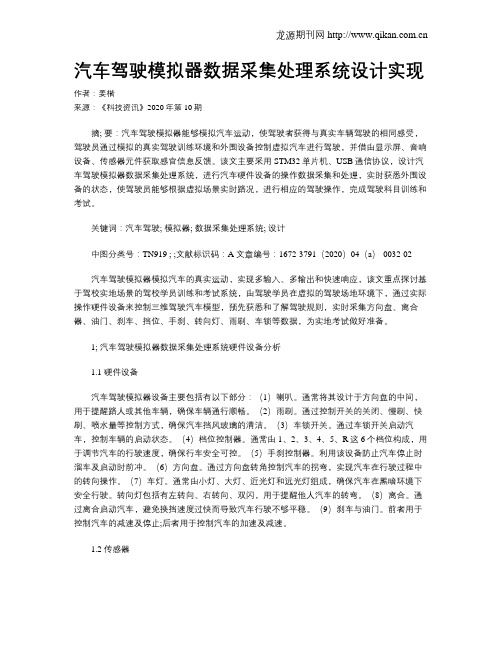汽车驾驶模拟器单片机系统设计
- 格式:docx
- 大小:13.72 KB
- 文档页数:6


西北工业大学明德学院本科毕业设计论文本科毕业设计论文题目基于单片机的汽车灯控系统模拟设计专业名称学生姓名指导教师毕业时间西北工业大学明德学院本科毕业设计论文I毕业一、题目:基于单片机的汽车灯控系统模拟设计二、指导思想和目的要求:通过毕业设计,使学生对所学电子工艺、电路基础知识、模电、数电、等电子基础课程的基本知识加深理解,掌握单片机的基本指令及基本结构,并将其与实际工程应用紧密结合起来,培养创新意识,增强分析问题解决问题能力,为尽快进入社会角色,熟悉相关开发工作流程、项目小组组成、分工、合作方式方法等。
增强团队合作意识,提高基本工作技能,为即将踏入社会奠定理论和实践基础。
内容:汽车在行驶时,有左转弯、右转弯、刹车、警示等操作。
左转弯时,应使左头灯、左尾灯、仪表板左转指示灯闪烁。
右转弯时,应使右头灯、右尾灯、仪表板右转指示灯闪烁。
刹车时,左右两个尾灯亮。
警示时,头灯、尾灯、仪表板指示灯等6个灯全闪烁。
(1)设计思路:运用所学单片机知识,运用其I/O 口设计基本控制电路,并以发光管、蜂鸣器、按键等外部设备做为相应的模拟部件。
(2)步骤:l 、了解汽车灯控系统的工作原理及要求。
2、设计单片机工作的基本电路,如:晶振电路、复位电路。
3、根据系统设计要求选择发光二极管、蜂鸣器、按键等模拟部件。
4、设计系统基本电路。
5、绘制PRTUSE 电原理图并编写系统控制程序。
6、联机进行系统仿真调试。
西北工业大学明德学院本科毕业设计论文三、进度与要求:1.第一周~第一周收集汽车电子相关资料。
2.第二周~第三周用PROTUSE设计硬件原理图并进行器件选型。
3.第四周~第六周编写系统各功能模块控制程序。
4.第七周~第十周联机进行系统调试。
5. 第十一周~第十二周整理并组织论文。
6.第十三周~第十四周完成修改稿,定稿,打印,交评阅。
7.第十五周~第十六周评阅与答辩学生指导教师系主任I I西北工业大学明德学院本科毕业设计论文摘要随着单片机的日益发展,其应用也越来越广泛,通过对“汽车灯控制系统”设计,可以对单片机的知识得到巩固和扩展。

基于单片机的汽车疲劳驾驶报警系统设计方案1 前言在高速发展的现代,拥有汽车的人是越来越多,交通越来越拥挤,正是因为如此,交通事故也越来越频发,这就促使人们正视这一问题。
而在交通事故中,因为驾驶员疲劳驾驶引起的事故,占其中相当大的一部分,疲劳驾驶已经成为威胁我们生命的一大危害,了解疲劳驾驶以及它引发的一些变化,有助于我们找到原因以及克服它的方法,可以在驾驶员行驶时发生突发或者无意识的疲劳困倦进行警醒,从而一定程度上避免车祸的发生。
1.1 什么是疲劳驾驶疲劳驾驶就是驾驶员较长时间维持一个姿势或者休息时间不够等原因造成的反映迟钝,驾驶员打盹、疲乏、操作不当甚至完全丧失驾驶能力就是它的主要表现。
并且,疲劳驾驶不仅反映在心理上,还反映在生理上。
心理上的反应包含反应时间延迟、出现动作不协调、大脑注意力分散等;生理反应上包括神经系统、血液、眼睛、握力等的变化。
1.2 疲劳驾驶与交通事故据相关调查显示,发生交通事故的原因百分之八十五是与驾驶员有关的,环境与车辆的因素只是占到百分之十五,司机在事故发生前的那么一瞬间的行为以及故障会直接导致交通事故的发生,知觉上的延迟、对危险情况的错误抉择、对环境的决策错误等就是导致交通事故的一些因素;而在所有的驾驶员所犯的错误中,决策错误和知觉延缓是最为常见的,而这些就会使驾驶员产生反应迟钝、注意力不集中等反应,产生这些错误的根本的原因就是疲劳驾驶。
所以,在一定程度上制止驾驶员疲劳驾驶这一行为现象,就能有效的减小交通事故发生的概率。
1.3 怎么预防疲劳驾驶许多的国家已经意识到疲劳驾驶的问题,对于它的研究工作早期上主要是使用在医学角度上,是在医疗器械的帮助下实现的,这些研究可以追溯到上个世纪三十年代美国交通部下辖的洲际商业协会对城市商业机动车辆的驾驶员服务时间的管理条例的合理性进行的调查;而实质性研究汽车驾驶员与疲劳驾驶的关系是从上世纪八十年代初开始的,由美国国会批准交通部实施改革驾驶服务时间,探索驾驶员和道路安全的关系,提高完善公共汽车安全法规开始的,我们发现疲劳驾驶研究的高度提高到了立法,可以在一定程度上保证疲劳驾驶研究的有效性、合法性和持续性[7]。

基于单片机的智能小车的系统设计Design of Intelligent Car System Based on MCU基于单片机的智能车设计[摘要]近几年来,智能车辆己成为汽车和智能控制领域的热点研究课题之一。
它体现了自动控制、人工智能、传感技术、机械、计算机等多个学科领域理论技术的交叉和综合,本论文以飞思卡尔智能车大赛光电组为背景而展开。
智能车系统以Freescale 16位微控制器MC9S12XS128作为系统控制处理器,采用基于光电传感器的信号采样模块获取赛道黑线信息,通过PID控制策略和 PWM控制技术对智能车的转向和速度进行控制。
使智能车能够自主识别黑色引导线并根据黑色引导线实现快速稳定的寻线行驶。
本论文分析了智能车系统的设计方案,详细介绍了智能车控制系统的软硬件设计,包括传感器模块、驱动电机模块、舵机转向模块、测速模块等,并详细介绍了软件控制算法的设计,最后,介绍了智能车的整体调整、测试。
调试实验结果表明,智能车系统工作稳定,能较好的满足控制要求。
[关键词]智能汽车;MC9S12XS128;光电传感器;控制算法Design of Intelligent Car System Based on MCUElectrical Engineering and Automation Major SHI Xiao-ying Abstract: In recent years, intelligent vehicles have become a hot research topic of cars and intelligent control area. It embodies the automatic control, artificial intelligence, sensor technology, machinery, computers and many other areas of the intersection of technology and integrated.The intelligent car system, with the Fresscale 16-bitsingle-chip MC9S12XS128 as its control microprocessor, uses signal acquisition module to obtain lane image information, and adopts signal PID control strategy together with PWM technology to have a control on the steering angle and speed of the system. The main function that the intelligent car may achieve is that the car should track the black-guide-line automatically and move forward following the line as fast and stable as possible. This paper gives an overall design blueprint of the intelligent car system, introduce the hardware design including signal acquisition module, power supply module, motor drive module, servo motor module, velocity collection module and etc. and the intelligent car of the mechanical structure and adjustment method. Finally, on the smart car’s overall debugging and testing, the results show the s mart car hardware system stability, better able to meet the requirements of control.Key words: intelligent vehicles; MC9S12XS128; Photoelectric sensor; Control algorithm目录1 引言 (1)1.1 课题背景 (1)1.2 智能技术国内外发展现状 (1)1.3 课题研究的任务 (1)2 整体设计方案 (2)2.1 路径识别传感器的选定 (2)2.2 系统总体框图 (3)3 硬件电路设计 (4)3.1 MCU模块 (4)3.2 电源管理模块 (5)3.3 路径识别模块 (6)3.3.1 光电传感器原理 (6)3.3.2 传感器的选择 (7)3.3.3 激光传感器电路设计 (7)3.4 电机驱动的选型和电路设计 (9)3.5 速度测量模块 (9)3.6 转向舵机控制模块 (10)3.6.1 舵机的控制 (11)3.7 MC9S12XS128的硬件I/O分配 (12)4 系统的软件设计 (12)4.1 系统初始化 (13)4.2 路径识别算法 (14)4.2.1 激光传感器路径识别状态分析 (14)4.2.2 路径识别算法的设计 (17)4.3 转角和速度控制算法 (17)4.3.1 转向舵机控制算法 (18)4.3.2 驱动电机控制算法 (18)4.4 软件设计环境与开发工具 (19)结束语 (21)参考文献 (22)附录部分源程序 (22)致谢 (28)1 引言1.1 课题背景近年来随着汽车工业的迅速发展,关于汽车的研究也就越来越受到大家的关注。

汽车驾驶模拟器数据采集处理系统设计实现作者:姜楷来源:《科技资讯》2020年第10期摘; 要:汽车驾驶模拟器能够模拟汽车运动,使驾驶者获得与真实车辆驾驶的相同感受,驾驶员通过模拟的真实驾驶训练环境和外围设备控制虚拟汽车进行驾驶,并借由显示屏、音响设备、传感器元件获取感官信息反馈。
该文主要采用STM32单片机、USB通信协议,设计汽车驾驶模拟器数据采集处理系统,进行汽车硬件设备的操作数据采集和处理,实时获悉外围设备的状态,使驾驶员能够根据虚拟场景实时路况,进行相应的驾驶操作,完成驾驶科目训练和考试。
关键词:汽车驾驶; 模拟器; 数据采集处理系统; 设计中图分类号:TN919 ; ;文献标识码:A 文章编号:1672-3791(2020)04(a)-0032-02汽车驾驶模拟器模拟汽车的真实运动,实现多输入、多输出和快速响应,该文重点探讨基于驾校实地场景的驾校学员训练和考试系统,由驾驶学员在虚拟的驾驶场地环境下,通过实际操作硬件设备来控制三维驾驶汽车模型,预先获悉和了解驾驶规则,实时采集方向盘、离合器、油门、刹车、挡位、手刹、转向灯、雨刷、车锁等数据,为实地考试做好准备。
1; 汽车驾驶模拟器数据采集处理系统硬件设备分析1.1 硬件设备汽车驾驶模拟器设备主要包括有以下部分:(1)喇叭。
通常将其设计于方向盘的中间,用于提醒路人或其他车辆,确保车辆通行顺畅。
(2)雨刷。
通过控制开关的关闭、慢刷、快刷、喷水量等控制方式,确保汽车挡风玻璃的清洁。
(3)车锁开关。
通过车锁开关启动汽车,控制车辆的启动状态。
(4)档位控制器。
通常由1、2、3、4、5、R这6个档位构成,用于调节汽车的行驶速度,确保行车安全可控。
(5)手刹控制器。
利用该设备防止汽车停止时溜车及启动时前冲。
(6)方向盘。
通过方向盘转角控制汽车的拐弯,实现汽车在行驶过程中的转向操作。
(7)车灯。
通常由小灯、大灯、近光灯和远光灯组成,确保汽车在黑暗环境下安全行驶。

版本:doc毕业设计基于单片机的智能小车控制系统设计附源程序代码第一章绪论第一章绪论1.1课题背景目前,在企业生产技术不断提高、对自动化技术要求不断加深的环境下,智能车辆以及在智能车辆基础上开发出来的产品已成为自动化物流运输、柔性生产组织等系统的关键设备。
世界上许多国家都在积极进行智能车辆的研究和开发设计。
移动机器人是机器人学中的一个重要分支,出现于20世纪06年代。
当时斯坦福研究院(SRI)的NilsNilssen和charlesRosen等人,在1966年至1972年中研制出了取名shakey的自主式移动机器人,目的是将人工智能技术应用在复杂环境下,完成机器人系统的自主推理、规划和控制。
从此,移动机器人从无到有,数量不断增多,智能车辆作为移动机器人的一个重要分支也得到越来越多的关注。
智能小车,是一个集环境感知、规划决策,自动行驶等功能于一体的综合系统,它集中地运用了计算机、传感、信息、通信、导航及白动控制等技术,是典型的高新技术综合体。
智能车辆也叫无人车辆,是一个集环境感知、规划决策和多等级辅助驾驶等功能于一体的综合系统。
它具有道路障碍自动识别、自动报警、自动制动、自动保持安全距离、车速和巡航控制等功能。
智能车辆的主要特点是在复杂的道路情况下,能自动地操纵和驾驶车辆绕开障碍物并沿着预定的道路(轨迹)行进。
智能车辆在原有车辆系统的基础上增加了一些智能化技术设备:(1)计算机处理系统,主要完成对来自摄像机所获取的图像的预处理、增强、分析、识别等工作;(2)摄像机,用来获得道路图像信息;(3)传感器设备,车速传感器用来获得当前车速,障碍物传感器用来获得前方、侧方、后方障碍物等信息。
智能车辆技术按功能可分为三层,即智能感知/预警系统、车辆驾驶系统和全自动操作系统团。
上一层技术是下一层技术的基础。
三个层次具体如下:(1)智能感知系统,利用各种传感器来获得车辆自身、车辆行驶的周围环境及驾驶员本身的状态信息,必要时发出预警信息。
致力于打造高品质文档基于单片机的智能汽车驾驶安全辅助系统的建设1 简介随着经济的快结束语本作品针对当前驾驶员驾驶汽车的一些安全隐患来特意开发的一套驾驶安全辅助系统,可以实时监测车内的CO、CO2的含量、驾驶员是否酒驾、是否遗留贵重物品在车内等,并通过语音以及手环等模块实时提醒驾驶员,让驾驶员更加安心驾驶,在一定程度上可以减少交通事故的发生。
2 系统总体结构2.1 系统总体结构本系统由单片机中控模块结束语本作品针对当前驾驶员驾驶汽车的一些安全隐患来特意开发的一套驾驶安全辅助系统,可以实时监测车内的CO、CO2的含量、驾驶员是否酒驾、是否遗留贵重物品在车内等,并通过语音以及手环等模块实时提醒驾驶员,让驾驶员更加安心驾驶,在一定程度上可以减少交通事故的发生。
动,达到提醒的效果。
2.2 系统硬件电路设计本设计采用的是一种基于结束语本作品针对当前驾驶员驾驶汽车的一些安全隐患来特意开发的一套驾驶安全辅助系统,可以实时监测车内的CO、CO2的含量、驾驶员是否酒驾、是否遗留贵重物品在车内等,并通过语音以及手环等模块实时提醒驾驶员,让驾驶员更加安心驾驶,在一定程度上可以减少交通事故的发生酒醒指令。
3 程序设计3.1 程序功能描述(1)实现AD1115 模数转换功能(2)实现读取酒精传感器模拟量/数字量功能(3)实现读取一氧化碳传感器模拟量/数字量功能(4)实现读取二氧化碳传感器模拟量/数字量功能(5)实现语音提醒功能(6)实现手环震动效果功能(7)蓝牙无线通信功能4 结束语本作品针对当前驾驶员结束语本作品针对当前驾驶员驾驶汽车的一些安全隐患来特意开发的一套驾驶安全辅助系统,可以实时监测车内的CO、CO2的含量、驾驶员是否酒驾、是否遗留贵重物品在车内等,并通过语音以及手环等模块实时提醒驾驶员,让驾驶员更加安心驾驶,在一定程度上可以减少交通事故的发生。
少交通事故的发生。
摘要汽车驾驶模拟器是一种用于汽车产品开发、“人—车—环境”交通特性研究或驾驶培训的重要工具。
近年来,由于具有安全性高、再现性好、可开发性强、成本低等显著特点,研究开发驾驶模拟器已经成为国内外一个重要发展方向。
本文在查阅国内外大量资料的基础上,结合老师的研究课题主要对六自由度汽车驾驶模拟器液压系统部分进行设计。
六自由度汽车运动模拟器采用液压伺服阀控制液压缸来驱动模拟平台的运动,以实现汽车驾驶模拟器运动姿态模拟。
本文主要进行机械机构的设计、液压伺服系统设计、液压泵站设计和液压缸的设计等。
通过模拟器的机构设计和驱动液压伺服系统设计,结合电气系统能够实现汽车在不同运行状态的模拟,当驾驶员坐在驾驶舱系统的座椅上进行模拟驾驶时,完全能够感受到实际汽车驾驶的各种体感,为实车训练驾驶提供了可替代的模拟平台;本设计也为今后的进一步研究及其在娱乐模拟器、动感电影等产业的实际推广和应用方面奠定了基础。
关键词:汽车驾驶模拟器六自由度运动平台液压伺服系统运动姿态控制AbstractThe Automobile-driving i an important tool which used for the development of auto mobile product and the study of the transportation characteristics of “man-car-environment”or the driver training .In recent years, the study of the automobile-driving simulator used for development has become an important development direction in the world because of the notable characteristics of high safety, well reappearance of scene, easy to develop and low cost.This article is based on searching the large quantity of information about at home and abroad, and combines with the tea cher’s research task which mainly designs the part of 6-dof driving Simulator of hydraulic system .The 6-dof motion simulator adopts valves of hydraulic servo to control actuator to drive the movement of driving simulation platform, and to achieve the movement posture simulation of the automobile driving simulator. This article is mainly about the designing of machine, the system of hydraulic servo, hydraulic pump station, and actuator and so on.According to the designing of agencies of simulator and hydraulic servo system, it can combines the electrical system which can bring out the imitation of cars in different movement conditions, when the driver simulating drive on the seat of cockpit system, you can feel the feeling of driving a true car, and it also offer the simulator platform which can be replaced for true driving training. At the same time, this designing is also establishes for the further researches and the practice extension and use.Keywords:Driving-automobile simulator, 6-dof of motion platform, the system of hydraulic servo, the control of campaign attitude目录1绪论 (1)引言 (1)国内外发展现状 (2)1.2.1国内外研究和发展概述 (2)1.2.2驾驶模拟器的应用和发展 (3)课题任务 (5)论文的主要研究内容 (5)2 运动学及力学分析 (6)六自由度运动模拟器机构位置反解 (6)2.1.1坐标系的建立 (6)2.1.2广义坐标定义 (6)2.1.3坐标变换矩阵 (7)2.1.4液压缸铰支点坐标的确定 (8)2.1.5位置反解 (10)六自由度运动模拟器机构位置正解 (11)静力学分析 (11)3 机械及液压部分设计 (12)运动模拟平台的设计 (12)3.1.1液压缸内壁D活塞杆直径d的计算 (12)3.1.2液压缸壁厚和外径的计算 (14)3.1.3缸盖壁厚的确定 (14)3.1.3液压缸工作行程的确定 (15)3.1.4缸体长度的确定 (15)3.1.5液压系统的计算 (15)液压泵站 (17)铰链的设计 (18)执行机构单元组成 (21)电液伺服控制单元与液压系统 (22)反馈单元 (23)4 电气部分设计 (24)电气原理及接口设计 (24)4.1.1MCS-51系列单片机的引脚及其功能 (24)4.1.2单个电液伺服液压缸位置控制电路设计 (26)4.1.3扩展电路 (26)电气原理图 (27)5 结论 (28)本文结论 (28)本文研究工作的不足 (28)参考文献 (29)致谢 (30)1绪论引言驾驶模拟器是一种用于汽车产品开发、“人-车-环境”交通特性研究或驾驶培训的重要工具。
基于单片机的智能小车控制系统设计本文从网络收集而来,上传到平台为了帮到更多的人,如果您需要使用本文档,请点击下载按钮下载本文档(有偿下载),另外祝您生活愉快,工作顺利,万事如意!摘要:本文主要研究了利用MCS-51系列单片机控制PWM信号从而实现对智能小车控制的方法。
本项目中采用了利用单片机对PWM信号的软件实现方法,并且通过对PWM信号占空比进行调节,从而控制其输入信号波形等均作了详细的阐述。
此外,本文中还采用了芯片L298N作为功率放大电路的驱动模块,把单片机输出的微弱的电流型号放大从而使电机满足转速的要求。
另外,本系统中使用四位共阳极数码管对电机的转速、方向进行监控,能够直观的观察电机的变化,通过独立键盘手动控制电机的转速。
关键词:智能小车;单片机;PWM;§引言随着科学技术的不断进步,电气工程与自动化技术正以令人瞩目的发展速度,改变着我国的工业的整体面貌。
同时,对社会的生产方式、人们的生活方式和思想观念也产生了重大的影响,并在现代化建设中发挥着越来越重要的作用。
随着与信息科学、计算机科学和能源科学等相关学科的交叉融合,它正在向智能化、网络化和集成化的方向发展。
现代工业生产中,电动机是主要的驱动设备,目前在直流电动机拖动系统中已大量采用晶闸管(即可控硅)装置向电动机供电的KZ—D拖动系统,取代了笨重的发电动一电动机的F—D系统,又伴随着电子技术的高度发展,促使直流电机调速逐步从模拟化向数字化转变,特别是单片机技术的应用,使直流电机调速技术又进入到一个新的阶段,智能化、高可靠性已成为它发展的趋势。
直流电机调速基本原理是比较简单的(相对于交流电机),只要改变电机的电压就可以改变转速了。
改变电压的方法很多,最常见的一种PWM脉宽调制,调节电机的输入占空比就可以控制电机的平均电压,控制转速。
PWM控制的基本原理很早就已经提出,但是受电力电子器件发展水平的制约,在上世纪80年代以前一直未能实现。
基于单片机的智能小车控制系统设计AbstractThe design of an intelligent car control system based on microcontroller is a complex task that requires the integration of various hardware and software components. This paper presents a detailed description of an intelligent car control system that enables the car to navigate autonomously and intelligently. The system has multiple sensors, including ultrasonic sensors and infrared sensors, that enable it to detect obstacles and navigate around them. In addition, the system has a Bluetooth module that allows it to communicate wirelessly with a remote device, such as a smartphone or tablet. The software implementation of the system is done using C programming language, and the hardware implementation is done using the STM32 microcontroller.IntroductionThe design of an intelligent car control system is a complex task that requires the integration of various hardware and software components. The system must be able to navigate autonomously and intelligently, avoid obstacles, and communicate with a remote device wirelessly. The objective of this paper is to present a detailed description of an intelligent car control system that meets these requirements. In this paper, we describe the hardware and software components of the system and explain how they work togetherto enable the car to navigate autonomously and intelligently.Hardware DesignThe hardware design of the intelligent car controlsystem consists of several components, including the STM32 microcontroller, various sensors, motor drivers, and a Bluetooth module. The STM32 microcontroller is the central processing unit of the system, and it is responsible for controlling the various components of the system. The microcontroller is connected to several sensors, including ultrasonic sensors and infrared sensors, that enable the carto detect obstacles and navigate around them. The ultrasonic sensors are used to detect objects in front of the car, while the infrared sensors are used to detect objects on the sidesof the car.The motor drivers are used to control the motors that drive the wheels of the car. The system has four wheels, each of which is driven by a separate motor. The motor drivers are connected to the microcontroller, and they receive signals from the microcontroller that tell them how fast to turn the motors. The Bluetooth module is used to communicatewirelessly with a remote device, such as a smartphone or tablet. The Bluetooth module is connected to the microcontroller, and it allows the user to control the carand receive data from the car wirelessly.Software DesignThe software design of the intelligent car controlsystem is implemented using the C programming language. The system software consists of several modules, including the obstacle detection module, the navigation module, and the Bluetooth communication module. The obstacle detection module is responsible for detecting obstacles in the path of the car. This module uses the data from the ultrasonic and infrared sensors to detect obstacles and send a signal to thenavigation module if an obstacle is detected.The navigation module is responsible for controlling the motors that drive the wheels of the car. This module receives data from the obstacle detection module and uses this data to control the motors. If an obstacle is detected, the navigation module will calculate a new course for the car and send signals to the motor drivers to turn the wheels in the appropriate direction. If no obstacles are detected, the navigation module will continue to drive the car in astraight line.The Bluetooth communication module is responsible for communicating with a remote device, such as a smartphone or tablet. This module allows the user to control the car wirelessly and receive data from the car. The user cancontrol the car by sending commands via Bluetooth, such as commands to drive forward, turn left, turn right, or stop. The user can also receive data from the car via Bluetooth, such as data on the car's speed, direction, and position.ConclusionThe intelligent car control system presented in this paper is a complex system that enables the car to navigate autonomously and intelligently. The system has multiple sensors, including ultrasonic sensors and infrared sensors, that enable it to detect obstacles and navigate around them. In addition, the system has a Bluetooth module that allows it to communicate wirelessly with a remote device, such as a smartphone or tablet. The software implementation of the system is done using C programming language, and the hardware implementation is done using the STM32 microcontroller. The intelligent car control system has the potential to be usedin a variety of applications, such as in industrialautomation, robotics, and unmanned vehicles, and is therefore an important area of research.。
书山有路勤为径;学海无涯苦作舟
汽车驾驶模拟器单片机系统设计
汽车驾驶模拟器是一种能正确模拟汽车的驾驶操纵动作,获得实车驾驶感觉的仿真系统。
目前的汽车驾驶模拟器集合了传感器、计算机三维实时动画、计算机接口、人工智能、数据通信、网络、多媒体等多种先进技术,主要用于驾驶员的培训,也可以对微观交通进行仿真,对汽车的控制特性进行研究[1]。
汽车驾驶模拟器具有安全性高、再现性好的特点。
利用驾驶模拟器来进行研究和训练,可方便地模拟各种道路环境、天气状况,分析汽车的技术性能指标,从而可以节省大量的自然资源,具有很高的经济价值[2]。
在汽车驾驶模拟器中,传感控制系统的性能直接影响到整个汽车驾
驶模拟系统的交互性和实时性,是衡量汽车驾驶模拟器实用性能的重要指标。
传感控制系统主要由各种传感器、数据采集和处理系统、以及接口电路等组成。
其中,数据采集和处理系统是整个传感控制系统的核心。
目前,很多汽车驾驶模拟器采用数据采集卡实现操纵数据的采集,这种基于数据采集卡的数据采集和处理系统成本相对较高,采集模拟量时不是很稳定,必须在仿真程序中采用专门的算法对模拟量进行处理,同时接口的数量也很有限,这为后续的开发带来了一些困难。
而基于单片机的数据采集系统虽然开发周期较长,但成本相对较低,接口的可扩展性好,同时,模拟量和开关量的预处理工作也可以由单片机来完成,完全可以满足模拟器系统的交互性和实时性要求。
下面介绍汽车驾驶模拟器单片机系统的设计思路。
专注下一代成长,为了孩子。